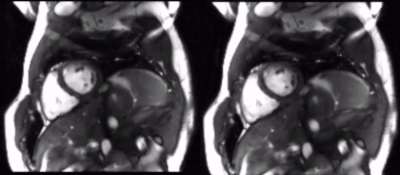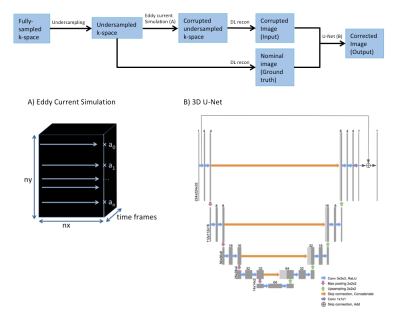Cynthia Chen1, Christopher Sandino2, Adam Bush3, Frank Ong2, and Shreyas Vasanawala3
1California Institute of Technology, Pasadena, CA, United States, 2Electrical Engineering, Stanford University, Stanford, CA, United States, 3Radiology, Stanford University, Stanford, CA, United States
1California Institute of Technology, Pasadena, CA, United States, 2Electrical Engineering, Stanford University, Stanford, CA, United States, 3Radiology, Stanford University, Stanford, CA, United States
Eddy currents due to changing magnetic fields reduce diagnostic image quality, especially in SSFP acquisitions. We propose a retrospective deep learning method that successfully reduces eddy current artifacts in 2D cardiac cine imaging.

Figure 4. Prospectively acquired data with optimal view ordering but apparent eddy current artifacts and prediction following application of 3D U-Net. (Left) A 2D cardiac cine dataset is prospectively acquired with 12X acceleration, then reconstructed using a model-based deep learning approach. Eddy current artifacts manifest as residual aliasing across the image. (Right) The images on the right are corrected using our 3D U-Net approach, resulting in reduction of eddy current artifacts.

Figure 2. Data processing pipeline. A) Eddy current effects of random phase encoding orderings were simulated by scaling each k-space line by a random amplitude in a randomly chosen range. B) 3D-Unet Architecture with an additive skip connection to enable residual learning. The input and output sizes are Nx224x224x32.